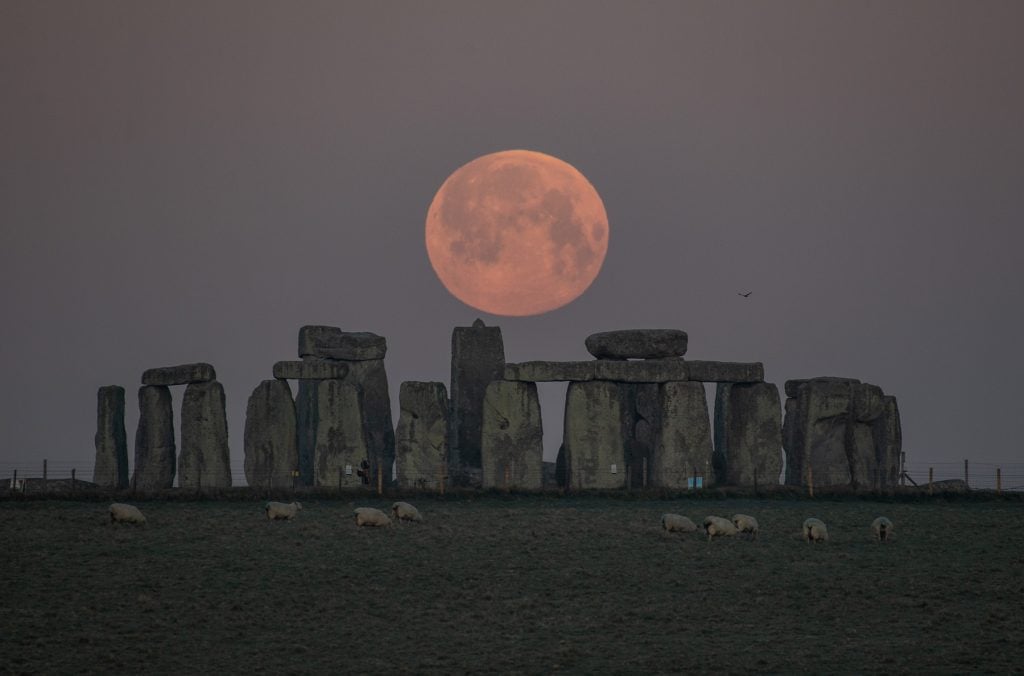 The full moon sets behind Stonehenge on April 27, 2021 in Amesbury, England. Photo by Finnbarr Webster/Getty Images.
The full moon sets behind Stonehenge on April 27, 2021 in Amesbury, England. Photo by Finnbarr Webster/Getty Images.
A long lost piece of England’s Stonehenge monument is helping experts understand the mysterious prehistoric structure.
Analysis of a core sample taken from one of the site’s massive slabs suggests that the stone’s geochemical composition may have made it uniquely well-equipped to stand the test of time.Made from 99.7 percent quartz crystals, the stones are practically indestructible, according to a new study published in the journal Plos One.“Now we’ve got a good idea why this stuff’s still standing there,” study co-author David Nash, a professor of physical geography at the University of Brighton, told Business Insider. “The stone is incredibly durable—it’s really resistant to erosion and weathering.”The study was made possible thanks to a former diamond cutter, Robert Phillips, who died last year.
He did repair work at Stonehenge in 1958, drilling into Stone 58 to help re-erect a fallen trilithon of three stones. READ MORE
Thousands of medieval Islamic tombs in eastern Sudan were arranged in hard-to-detect patterns, with sacred "parent" tombs hosting subclusters of emanating burials, according to archaeologists who studied the funerary monuments with a method designed for cosmology.
The team used satellite imagery to identify the locations of more than 10,000 monuments in the Kassala region of eastern Sudan. The monuments include tumuli, which are made of stone and are "relatively simple raised structures, widespread throughout African prehistory and history," and "qubbas," which is a term that referred to Islamic tombs and shrines in the pan-Arab world, a team of researchers wrote in a paper published July 7 in the journal PLOS One.
After the team mapped the funerary monuments, they had trouble interpreting the data, given that few of the monuments had been excavated.
"We faced the challenge of interpreting the creation of the funerary landscape with almost no traditional archaeological data, but [we had] a large enough data set to be able to hypothesize the presence of complex processes both at regional and local scale[s]," Stefano
Costanzo, a doctoral student in archaeology at the University of Naples L'Orientale in Italy and lead author of the journal article, told Live Science.
"To the naked eye, it was clear that the clustered tombs were conditioned by the environment, but deeper meaning may have been implied in their spatial arrangement," Costanzo said. He and other members of the team searched for statistical modeling techniques that could help them detect patterns. Ultimately, they decided on a method called the Neyman-Scott cluster process, which was originally developed to study the spatial patterns of stars and galaxies. As far as the team knows, archaeologists have never used the technique.
"The biggest feature of this model lies in the fact that it can deal with archaeological data sets that [lack excavation data and historical records] but are composed of a very large number of elements, which is the basis to meaningful statistical analyses," Costanzo said. TO READ ENTIRE ARTICLE, CLICK HERE...
 The full moon sets behind Stonehenge on April 27, 2021 in Amesbury, England. Photo by Finnbarr Webster/Getty Images.
The full moon sets behind Stonehenge on April 27, 2021 in Amesbury, England. Photo by Finnbarr Webster/Getty Images.